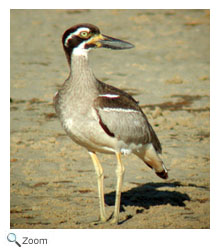Burhinidae - thick-knees
 This birds in this family are medium to large-sized wading birds. They are usually found in dry, tropical habitats in Africa, Europe, South America, Asia, and Australia. One species that breeds in North America, the double-striped thick-knee (Burhinus bistriatus), is found from southern Mexico south to northern Brazil. This birds in this family are medium to large-sized wading birds. They are usually found in dry, tropical habitats in Africa, Europe, South America, Asia, and Australia. One species that breeds in North America, the double-striped thick-knee (Burhinus bistriatus), is found from southern Mexico south to northern Brazil.
Thick-knees have longs legs with large knee joints, strong yellow or black bills, and large, round yellow eyes.
They are a speckled sandy-brown with white undersides.
Thick-knees are mostly nocturnal.
During the heat of the day, they stay hidden under bushes. At night they can be identified by their distinctive wailing calls. They eat insects and other invertebrates; some species will also eat small mammals and lizards.
Species include the Eurasian thick-knee, the great thick-knee, the Senegal thick-knee, and the Peruvian thick-knee.
World Status Key
 Least Concern Least Concern  Near Threatened Near Threatened  Vulnerable Vulnerable  Endangered Endangered  Critically Endangered Critically Endangered  Extinct in the Wild Extinct in the Wild  Extinct Extinct
Status and range is taken from ICUN Redlist. If no status is listed, there is not enough data to establish status.
US Status Key
 Threatened in US Threatened in US  Threatened in NH Threatened in NH  Endangered in US Endangered in US  Endangered in NH Endangered in NH  Breeds in NH Breeds in NH  Introduced Introduced
Status taken from US Fish and Wildlife and NH Fish and Game
New Hampshire Species |
|
North/Central American Species |
None
|
|
Double-striped Thick-knee - Burhinus bistriatus  |
Additional Information
Key:  Profile Profile  Photos Photos  Video Video  Audio Audio
Beach Thick-knee - Esacus giganteus     
The beach thick-knee is also known as the beach stone-curlew.
Source: Arkive Intended Audience: General Reading Level: Middle School
Beach Thick-knee - Esacus giganteus     
The beach thick-knee is found in Australia, Brunei, India, Indonesia, Malaysia, Myanmar, New Caledonia, Papua New Guinea, Philippines, Singapore, Solomon Islands, and Thailand.
Source: Internet Bird Collection Intended Audience: General Reading Level: Middle School
Bush Thick-knee - Burhinus grallarius      
The bush thick-knee is found in Australia, Indonesia, and Papua New Guinea.
Source: Internet Bird Collection Intended Audience: General Reading Level: Middle School
Double-striped Thick-knee - Burhinus bistriatus      
The double-striped thick-knee is found from southern Mexico south to Colombia, Venezuela and Brazil. It is also found in the Dominican Republic and Haiti.
Source: Internet Bird Collection Intended Audience: General Reading Level: Middle School
Double-striped Thick-knee - Burhinus bistriatus     
The double-striped thick-knee is mostly nocturnal.
Source: Brookfield Zoo Intended Audience: Students Reading Level: Elementary School
Eurasian Thick-knee - Burhinus oedicnemus       
The Eurasian thick-knee is also known as the stone-curlew.
Source: Arkive Intended Audience: General Reading Level: Middle School
Great Thick-knee - Esacus recurvirostris     
The great thick-knee is found in Cambodia, China, India, Iran, Laos, Myanmar, Nepal, Oman, Pakistan, Sri Lanka, Thailand, and Vietnam.
Source: Internet Bird Collection Intended Audience: General Reading Level: Middle School
Peruvian Thick-knee - Burhinus superciliaris    
The Peruvian thick-knee is found in Chile, Ecuador, and Peru.
Source: Internet Bird Collection Intended Audience: General Reading Level: Middle School
Senegal Thick-knee - Burhinus senegalensis     
The Senegal thick-knee is found in Africa from between the Sahara and the equator and in the Nile River Valley.
Source: Internet Bird Collection Intended Audience: General Reading Level: Middle School
Water Thick-knee - Burhinus vermiculatus     
The water thick-knee was once known as the Dikkop.
Source: AfriCam Intended Audience: General Reading Level: Middle School
Water Thick-knee - Burhinus vermiculatus     
The water thick-knee is mostly nocturnal, but it is more active during the day than most species in the thick-knee family.
Source: Kenya Birds Intended Audience: General Reading Level: Middle School |
 This birds in this family are medium to large-sized wading birds. They are usually found in dry, tropical habitats in Africa, Europe, South America, Asia, and Australia. One species that breeds in North America, the double-striped thick-knee (Burhinus bistriatus), is found from southern Mexico south to northern Brazil.
This birds in this family are medium to large-sized wading birds. They are usually found in dry, tropical habitats in Africa, Europe, South America, Asia, and Australia. One species that breeds in North America, the double-striped thick-knee (Burhinus bistriatus), is found from southern Mexico south to northern Brazil.
